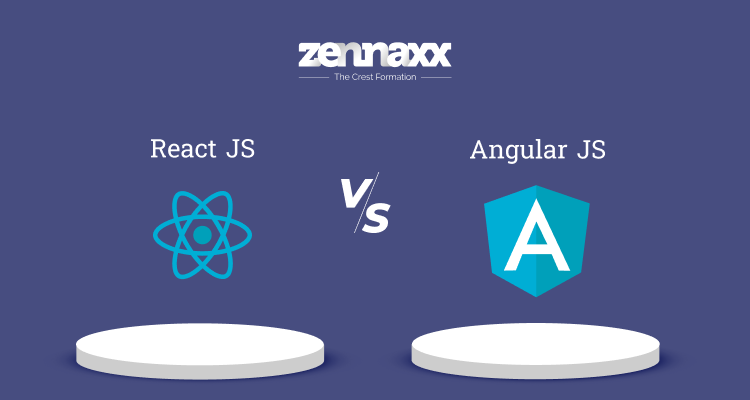Web development is growing at the same scale as technology. The need for creative and productive solutions drives the ongoing rise in web development. It fulfills the demands of developers and web development technology.
Angular.js and React.js are two of the most prominent front-end development frameworks in the extensive JavaScript framework.
The question that comes up is: which option stands as the best choice?
Should the selection be based on the project’s specific requirements? Should priorities like popularity take precedence in the initial stages? Or should ramp-up time be the priority?
Choosing between Angular.js vs is like picking the right tool for a project. You need to think about what your project needs and then compare the features of each framework.
Let’s discuss and determine the best option.
What is React.js?
React.js is a front-end JavaScript library designed for building user interfaces. It is mainly designed for creating dynamic and responsive single-page applications (SPAs).
It allows developers to construct UIs using reusable components and makes the front-end development process efficient and modular.
React.js supports server-side rendering, which improves performance by generating HTML on the server and sending it to the client, where the Virtual DOM (Document Object Model) is manipulated and updated.
In React.js, UIs are built using components, which are modular, reusable units of code. Components can have their own states and are composed to create complex user interfaces.

Pros and Cons of Using React.js in Project
Pros
Developers can migrate applications to React.js with relative ease.
Cons
JSX, while powerful, may have a learning curve for developers unfamiliar with it.
Developers must stay up to date with any rapid changes that React.js’s framework and best practices may experience.
For more straightforward applications, using React.js might create unnecessary complexity.
The Flexibility of React.js vs. Angular.js:
JSX Advantage
JSX, a syntax extension for JavaScript, allows mixing HTML with JavaScript libraries in React.js components, providing a concise and expressive syntax.
Building Blocks Flexibility
React.js provides more flexibility in terms of organizing and structuring the building blocks of an application.
Isomorphic JavaScript
React.js enables the development of isomorphic JavaScript applications, where the same code can run on both the server and the client.
Single Data Binding
React.js follows a unidirectional data flow, offering a more straightforward approach to handling data binding compared to Angular.js’s bidirectional data binding.
What is Angular.js?
Angular.js, an open-source front-end web application framework crafted and continually supported by Google’s Angular.js team, is extensively utilized for constructing scalable and high-performance mobile and web applications using HTML, CSS, and TypeScript.
Embracing a modular and structured architecture, Angular.js employs the MVC (Model View Controller) technique, enriching the front-end development process.
Distinguished by a robust two-way data binding technique, Angular.js establishes a seamless link between the user interface (UI) and the underlying data model. This reciprocal connection ensures that alterations in the UI automatically update the model and vice versa.
Angular.js’ architectural prowess lies in its modular design, systematically breaking down applications into smaller, more manageable modules. Each module encapsulates specific functionality, facilitating the organization and maintenance of intricate applications.
Furthermore, Angular.js integrates dependency injection, a design pattern streamlining the management and injection of dependencies into components. This enhancement promotes code reusability, testability, and overall maintainability.
Pros and Cons of Using Angular.js
Pros
MVC Model
Angular.js employs the MVC architecture, providing a structured approach to organizing and managing application code.
Dependency injection in Angular.js promotes modularity and code maintainability by injecting dependencies where needed.
Two-way data binding simplifies the synchronization of data between the model and the view, reducing boilerplate code.
Cons
Angular.js has a steeper learning curve compared to some other frameworks, especially for beginners.
The framework’s size might be considered significant for smaller projects, impacting initial load times.
The opinionated nature of Angular.js may limit flexibility compared to more lightweight libraries.
Feeling torn between React and Angular?
Let us shed light on your decision-making journey and direct you towards the best solution. Contact us today to start your journey!
What Makes Angular.js Stronger than React.js:
MVC Model
Angular.js enforces a clear MVC architecture, making it easier to manage and understand the structure of the application.
Dependency Injection
Dependency injection in Angular.js promotes modular and reusable code.
Out-of-the-Box Full Stack Framework
Angular.js is a comprehensive full-stack framework that provides solutions for various aspects of web development.
Two-way Data Binding
Angular.js’s two-way data binding simplifies the synchronization of data between components and the view.
Amazing App Structure
Angular.js encourages a well-organized application structure, facilitating scalability.
Key Differences of React.js vs. Angular.js
After knowing the basic designs and work differences. We have just covered the essential weak points and strong points of each JavaScript framework.
Also, we have defined the point when each JavaScript framework is robust on its own. React.js and Angular.js have several critical web development comparisons in terms of their design principles and approach to building web applications.
Let’s now discuss the main differences between React.js and Angular.js.
Architecture and Design
React.js’s Component-Based Structure
React.js follows a component-based architecture, where the user interface is built using modular, reusable components. Components encapsulate their own state and behaviour, making the codebase more modular and easier to maintain. The Virtual DOM efficiently updates only the necessary parts of the actual DOM, improving React.js performance.
Angular.js’s Modular MVC Architecture
Angular.js contains a modular architecture and follows the MVC (Model View Controller) design pattern. Applications are divided into logical modules, each containing components, services, and other features. The MVC architecture separates concerns, promoting modularity, testability, and maintainability.
Data Binding Process
React.js’s Unidirectional Data Flow
React.js follows a unidirectional data flow, where data flows in a single direction—from parent components to child components. Changes in the application state trigger updates, and the Virtual DOM efficiently manages the rendering process.
Angular.js’s Two-Way Data Binding
Angular.js features two-way data binding, allowing automatic synchronization between the model and the view. Changes in the UI update the underlying model, and vice versa, without the need for explicit event handling.
Learning Curve
React.js’s Simplicity and Gradual Learning Curve
React.js is known for its simplicity and a relatively gradual learning curve. Developers can start building applications with a basic understanding of JavaScript libraries and gradually delve into more advanced concepts as needed.
Angular.js’s Steeper Learning Curve Due to Comprehensive Features
Angular.js has a steeper learning curve, mainly due to its comprehensive feature set and a more opinionated approach. Developers need to familiarize themselves with concepts like dependency injection, TypeScript, decorators, and the Angular.js CLI.
React.js emphasizes a component-based structure with unidirectional data flow, providing simplicity and flexibility.
On the other hand, Angular.js employs a modular MVC architecture with two-way data binding, offering a more comprehensive solution but requiring a steeper learning curve.
The choice between React.js and Angular.js often depends on project requirements, developer preferences, and the complexity of the application being developed.
Performance Difference Between React.js vs. Angular.js
The web development comparison between React.js and Angular.js in terms of performance often depends on the specific requirements of the project, the development team’s familiarity with the JavaScript frameworks, and the desired balance between built-in features and bundle size optimization.
Rendering Efficiency
React.js’s Virtual DOM for Efficient Updates
React.js employs a Virtual DOM that acts as a lightweight copy of the actual DOM. When changes occur, React.js calculates the most efficient way to update the Virtual DOM.
Only the necessary parts of the real DOM are updated, reducing the computational load and enhancing rendering efficiency. This approach contributes to React.js’s ability to provide fast and responsive user interfaces.
Angular.js’s Larger Bundle Size Due to Built-in Features
React.js’s Virtual DOM contributes to efficient updates, minimizing the impact on rendering performance. Its minimalistic approach allows for smaller bundle sizes, giving developers more control over the dependencies they include.
Angular.js’s two-way data binding, while powerful, may introduce some performance considerations, particularly in larger applications. Additionally, the built-in features contribute to a larger bundle size, requiring careful optimization strategies.
Community and Ecosystem of both Platforms
The benefits of React.js are its large and active community, which fosters innovation, collaboration, and a wealth of resources. The advantage of Angular.js is its mature ecosystem, official Google support, and strong presence in enterprise-level applications.
React.js’s Large and Active Community
Community Size
- React.js has a large and vibrant community of developers worldwide.
- The community actively contributes to the framework’s growth and improvement.
Active Development
- React.js is continually evolving, with regular updates and new features being introduced.
- The community-driven development model ensures a steady stream of innovations and improvements.
Abundance of Resources
- A vast array of tutorials, blogs, and online forums are available, making it easy for developers to find support and solutions to common issues.
Third-Party Libraries
- React.js benefits from a rich ecosystem of third-party libraries and components, allowing developers to extend functionality and build upon existing solutions.
Angular.js’s Mature Ecosystem and Official Support from Google
Mature Ecosystem
- Angular.js has a mature and well-established ecosystem backed by official support from Google.
- The ecosystem includes a wide range of tools, libraries, and extensions to enhance the development process.
Official Support
- Angular.js is developed and maintained by Google, providing a sense of stability and long-term support.
- Enterprises often value the assurance of official backing when adopting a technology for critical projects.
Endorsement in Enterprises
- Angular.js is commonly adopted in enterprise-level applications, and its ecosystem includes features like Angular.js CLI (Command Line Interface) for streamlined development.
Documentation and Learning Resources
- Angular.js offers comprehensive documentation and learning resources, catering to both beginners and experienced developers.
Availability of Third-Party Libraries and Resources for Both Frameworks
React.js
React.js’s extensive community has led to a vast collection of third-party libraries and resources. The NPM (Node Package Manager) registry is a crucial resource for React.js developers to discover and integrate libraries seamlessly.
Angular.js
Angular.js benefits from a variety of third-party libraries available via tools like NPM. The Angular.js Package Format ensures consistency in how libraries are created and consumed within the Angular.js ecosystem.
Both React.js and Angular.js have robust communities, and the choice between them often depends on project requirements, team preferences, and the specific needs of the application being developed.
Want to Automate Your Business Process With a Software Solution?
Zennaxx, a leading software development firm in Canada, has delivered 700+ bespoke solutions spanning various industries.
Future Considerations – React.js vs. Angular.js
React.js continues to be a preferred choice for single-page application development, known for high reusability, robustness, and scalability. As of November 2022, approximately 11.9 million websites use React.js, indicating its widespread adoption.
1. Latest Version Analysis (React.js 18.2.0)
- React.js 18.2.0, released in June 2022, introduces features like automatic batching, server components, and asynchronous rendering boundaries for performance optimization.
- The JavaScript framework evolves with new features and updates, enhancing efficiency and practicality for developers.
2. React.js Features and Usage in Web Development
- React.js maintains attention due to optimized performance, advanced tooling, and continuous updates.
- Impressive features like support for a virtual DOM, easy integration with other JavaScript libraries, and a shallow learning curve contribute to its popularity.
- React.js powers large-scale applications, including Facebook, Netflix, and Instagram, showcasing its capabilities in complexweb development.
3. Future of React.js
- React.js’s increasing popularity and versatility point towards a promising future.
- Demand for React.js developers is rising across various industries like healthcare, finance, e-commerce, and entertainment.
- Technologies like React.js Native and React.js VR extend their applications to cross-platform mobile app development and virtual reality experiences.
4. New Tools and Frameworks for React.js Development
- React.js’s popularity has led to the development of tools and frameworks, including Next.js, Gatsby, Storybook, and Redux Toolkit, enhancing the development experience.
5. Latest Version Analysis (Angular.js 17)
- Angular.js 17 introduces support for advanced browser features, improved build performance, and updates to the Material UI library.
- The framework’s continual development and support from Google contribute to its relevance.
6. Angular.js Features and Usage in Development
- Angular.js’s comprehensive set of functionalities, including data binding, dependency injection, and pre-designed components, makes it suitable for various applications.
- Robust data binding capabilities and a wide range of applications contribute to Angular.js’s efficiency and popularity.
7. Future of Angular.js
- Angular.js’s future holds promise with continued improvements and adaptations to new technological breakthroughs.
- Its applications are expected to expand across various industries, including eCommerce, healthcare, education, finance, government, and gaming.
8. Angular.js New Features and Enhancement
- Angular.js introduces features like strict typing. It also reduces framework overhead, improves testing times, and enhances debugging capabilities.
- The flexibility of using ngc outside the Angular.js CLI and optional NgModulars enhances development efficiency.
Decision Factors for Choosing Between React.js and Angular.js
Choosing between React.js and Angular.js for a project involves considering various factors that align with the project’s requirements and the team’s expertise.
Here are critical decision factors:
1. Project Requirements and Goals
React.js:
Best suited for projects where flexibility and speed of development are crucial. Ideal for single-page applications (SPAs) and projects requiring a high level of component reusability. Well-suited for projects with dynamic and interactive user interfaces.
Angular.js:
Suitable for larger projects with complex structures and enterprise-level applications. Offers a comprehensive set of features out of the box, making it a good fit for projects with diverse requirements. Well-suited for projects where a more opinionated framework and consistent Angular.js architecture are preferred.
2. Developer Team Expertise
React.js:
Has a shallower learning curve, making it easier for developers to get started. Ideal for teams with expertise in JavaScript and a preference for a more flexible and less opinionated framework.
Angular.js:
Requires a steeper learning curve due to its comprehensive features and a more opinionated structure. Suited for teams with experience in TypeScript and a preference for a full-fledged framework with built-in tools.
3. Community Support and Long-Term Considerations
React.js:
Boasts a large and active community, contributing to its continuous growth and improvement. Widely adopted by various companies and industries, ensuring long-term support and updates. Abundance of third-party libraries and resources from the community.
Angular.js:
Supported by Google, providing a sense of stability and long-term backing. Popular in enterprise-level applications, with solid support and updates from the Angular.js team. Robust ecosystem with tools and libraries backed by official support.
4. Scalability and Project Size
React.js:
Excels in scalability, particularly for projects where modular components can be efficiently managed. Well-suited for both small and large projects but particularly favoured for projects that may grow over time.
Angular.js:
Designed with scalability in mind, making it suitable for large and complex applications. Offers a modular MVC Angular.js architecture and dependency injection, providing structure for extensive projects.
5. Integration with Other Technologies
React.js:
React.js is Known for its flexibility and compatibility with various libraries and tools. It integrates well with tools like Redux for state management. It integrates Next.js too for server-rendered applications.
Angular.js:
Angular.js offers a complete solution with built-in features like Angular.js CLI. It makes it a comprehensive choice for end-to-end development. Smooth integration with other Google products and services.
The choice between React.js and Angular.js depends on the project’s requirements. It also requires the development team’s expertise, long-term support, and scalability considerations.
Both frameworks have proven successful in different scenarios. Selecting the right one requires a careful evaluation of these decision factors.
Conclusion
The decision to opt for React vs Angular in front-end development hinges on project requirements, team proficiency, and long-term objectives. Developers must assess scalability, integration capabilities, and team expertise when selecting between React.js and Angular.js. As both frameworks continually evolve to align with modern web development standards, success pivots on choosing the most fitting tool for the task at hand.
At Zennaxx, our suite of technology solutions leverages both front-end and back-end development to engineer streamlined user experiences.
This commitment ensures the delivery of cutting-edge, future-proof solutions aligned with current trends. Connect with us to embark on a new project or enlist the expertise of our top-notch development team for your business.


